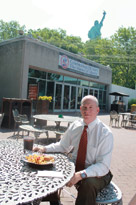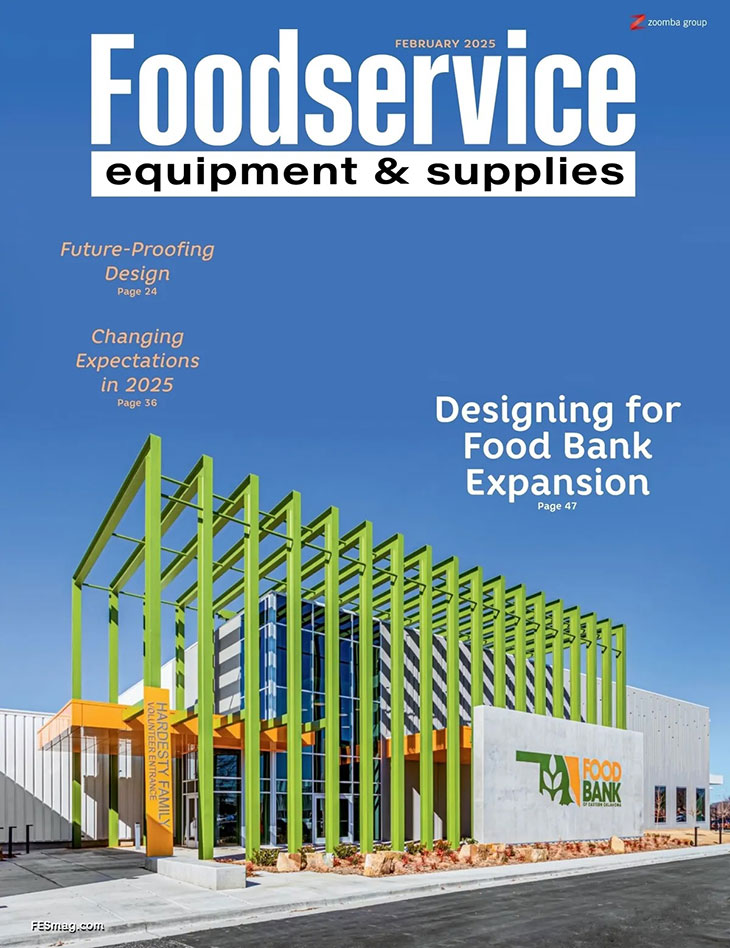More than 3 million tourists from all over the world visit the Statue of Liberty each year. As a result, the foodservice operations on Liberty Island average more than 2,200 transactions per day. Despite doing such a high volume, the foodservice operation has a 94 percent waste diversion rate.Each year, 3 million tourists from all over the world visit the Statue of Liberty and another 2 million make the trip to visit nearby Ellis Island. The popularity of these two attractions within the National Parks system is simple. "The Statue of Liberty is the world's icon and Ellis Island tells America's story," said Bob Uffer, general manager for Evelyn Hill Inc., which oversees the foodservice for both Liberty and Ellis Islands in New York City.
 Of course, the people visiting these two locations come with more than a healthy appetite to learn about America's past. They also take advantage of the foodservice options available on both islands. In fact, combined, the various foodservice outlets on Liberty Island average 2,200 transactions per day, while Ellis Island's foodservice outlets average another 1,100 transactions per day, according to Uffer, a 30-year veteran of the foodservice industry.
Of course, the people visiting these two locations come with more than a healthy appetite to learn about America's past. They also take advantage of the foodservice options available on both islands. In fact, combined, the various foodservice outlets on Liberty Island average 2,200 transactions per day, while Ellis Island's foodservice outlets average another 1,100 transactions per day, according to Uffer, a 30-year veteran of the foodservice industry.
Naturally, one would think an operation of this size and scope would generate a considerable amount of trash. But, according to Uffer, both islands have a 94 percent waste diversion rate. "If you carry out our garbage between the two islands at the end of the day it weighs 157 pounds. If you look at your garbage at home, on any given day it weighs 30 to 50 pounds," Uffer says. "So when you look at what we are doing between the two islands, that's pretty significant."
Of course, a 94 percent diversion rate does not happen by accident. It is, in fact, a pretty labor-intensive process and can only happen by design. The process
begins with employee orientation, during which new hires tour the entire facility and receive training on every aspect of the foodservice operation so they know how their actions impact one another. "You try to rotate the employees so they can see what each other does when they first start," Uffer says.
On the customer side of the business, busboys and other staff will begin the process by sifting through the waste and sorting before it goes to the back of the house. Once the waste arrives in the back of the house it gets dumped on to a stainless steel dishtable, where up to five staff members — the number varies depending on the season and visitor counts — work daily in the recycling department to sort it into the following waste streams: garbage, glass and aluminum, compost, cardboard and plastic. "Sorting through the waste is probably not the most desirable job and it is a tough job that requires a certain demeanor," Uffer added. "So any kind of support you can give them in the front of the house is helpful."
Because all of this takes place on an island where real estate is at a premium, efficient use of space is important, too. For example, Evelyn Hill uses a trash compactor to bail the cardboard and bottles. "And everything is in super stacks and on pallets. We put it in an assigned area," Uffer added.
Evelyn Hill transports all of the trash, compost and recyclable items from Liberty Island via boat to Ellis Island. A carting company then uses a service bridge to access Ellis Island and hauls these items to their final destinations.
While time consuming and tedious the results are enough to draw a smile of approval from Lady Liberty herself: 23.5 tons of compost per year, 57 tons of recycled cardboard, 18.5 tons of recycled plastic, 1.7 tons of recycled glass and aluminum and more than 3,000 pallets are recycled. In addition, all of the used fryer oil gets a second life as it's directed to a machine that helps make electricity for the Gift Pavilion.
For its efforts the Evelyn Hill team received a sustainability award from the National Restaurant Association before the association ultimately named the company its 2012 Operator Innovator of the Year. "When we received the sustainability award, I felt so great and so proud as I was surrounded by the industry's rock stars who were in attendance at the Awards dinner in Chicago during the National Restaurant Association's annual show. And then they called our name as the operator innovator of the year. That was amazing to receive that honor. And at that point I felt like a rock star among rock stars," Uffer says.
Of course, the waste management aspect of operations like this can be rather costly, particularly when it is surrounded by water. Uffer estimates that Evelyn Hill commits 6 percent of its total workforce for both islands to its waste management efforts. "Any time you want to do something better for the environment it costs you more money," he said.
Developing a program like this takes buy-in from the top before it can permeate the company, which is the case at Evelyn Hill. "Brad Hill (the third-generation president and owner of the company) looks at this as something we need to do. Other companies will look at it as a secondary initiative," Uffer said. "And the employees are behind it 100 percent. They are the ones that make it happen. If you don't get buy in from the employees, you'd be a failure. Brad has created a culture where people want to buy in."
Achieving a 94 percent diversion rate would be enough for most foodservice operators but Uffer and the Evelyn Hill team continue to look for ways to improve. "Our goal is to get to 100 percent. But moving forward it gets harder and harder so I will ask our vendors who support us to help us figure out ways for us to reduce that 6 percent," he said.
As a result, Uffer and the entire Evelyn Hill management team continue to look for new ways to lessen their operations' impact on the environment. They added a dish area and transitioned to reusable platters for serving food. And this year they will switch to melamine dishware and reusable glasses.
For those foodservice operators looking to make their businesses more sustainable, Uffer offers the following tips:
Start slowly and look at everything you do and how you do it. It's what we do anyway but you don't normally do it with the environment in mind. So just look at what you do on an item by item basis. Now the answer may not be readily available, so you may have to do some research.
Talk to your vendors. But they may not know and then you have to ask to meet with their manufacturers' reps to help get the answers you want. You need to use your resources and not be afraid to ask questions.
Look at what other operators do and share your practices with them. How do they do it? Some of the best ideas you have are the ones you steal. It is ok to look at what other people are doing and ask why aren't we doing that?




